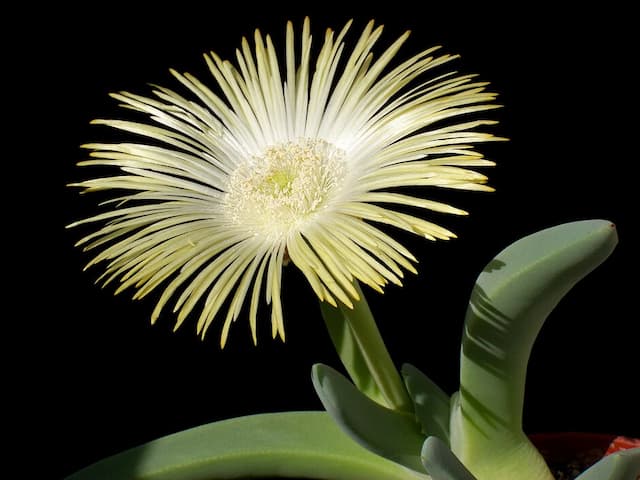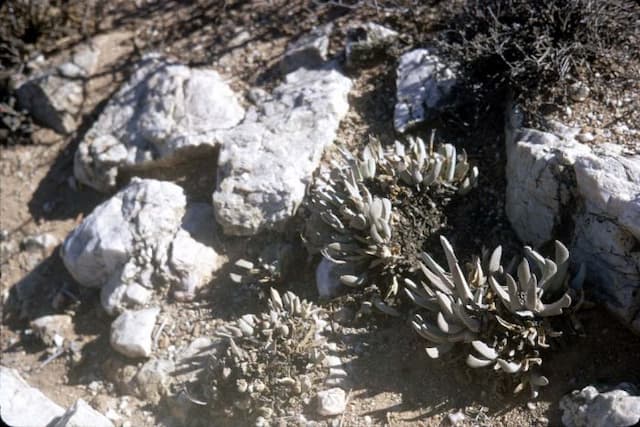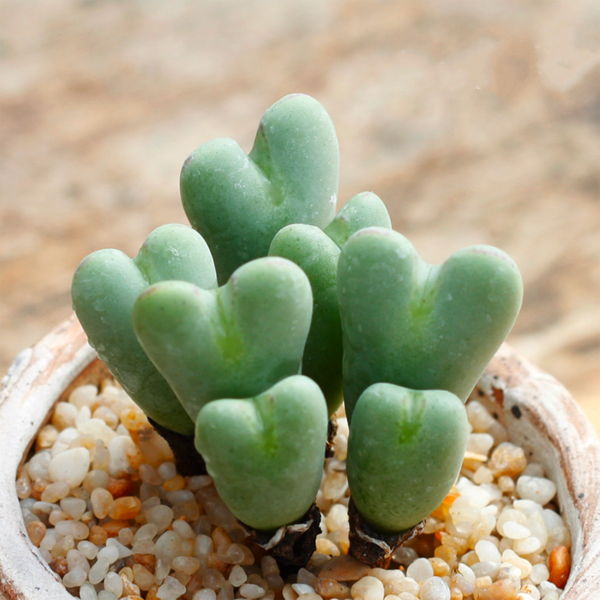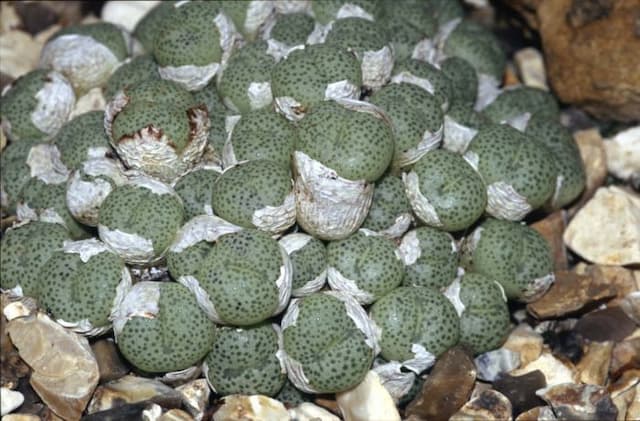Ice Plant Delosperma 'Beaufort West'

ABOUT
Delosperma 'Beaufort West', commonly known as ice plant, is a succulent that is known for its vibrant and colorful appearance. The plant displays fleshy, small, cylindrical leaves that are green in color, creating a dense mat-like groundcover. The leaves are often covered with tiny, glistening dots that can make them appear as if they are covered in frost, hence the name "ice plant." The ice plant produces daisy-like flowers with numerous slender petals radiating outward from a central disc. These blooms can be a vivid and bright color, such as pink, purple, or yellow, that adds a splash of color to gardens and landscapes. The flowers typically open during the sunny parts of the day and close at night or during overcast conditions. They are known for attracting pollinators like bees and butterflies. The overall appearance of Delosperma 'Beaufort West' is one of low-growing, spreading vibrancy. Its succulent leaves combined with the brilliant flowers create a lush carpet that thrives in sunny environments. This tapestry of greenery and blooms can provide a striking contrast to rock gardens, slopes, and borders where it is used for its textural and visual appeal.
About this plant
 Names
NamesFamily
Aizoaceae
Synonyms
Ice Plant, Hardy Ice Plant, Beaufort West Ice Plant
Common names
Delosperma 'Beaufort West'.
 Toxicity
ToxicityTo humans
Delosperma 'Beaufort West', commonly known as ice plant, is not known to be toxic to humans. There are no well-documented symptoms of poisoning from the ingestion of this plant, as it is generally considered safe. However, it is usually not recommended to consume any part of ornamental plants due to potential risks of gastrointestinal discomfort or allergic reactions in sensitive individuals.
To pets
The ice plant is also not known to be toxic to pets. It is considered non-toxic to cats, dogs, and other animals. There are no specific symptoms associated with the ingestion of ice plant by pets, suggesting that it is generally safe for animals as well. However, as with humans, ingesting plant material can sometimes lead to gastrointestinal upset in pets, so it is advisable to prevent pets from consuming plants not intended for consumption.
 Characteristics
CharacteristicsLife cycle
Perennials
Foliage type
Evergreen
Color of leaves
Green
Flower color
Pink
Height
0.25 feet (0.08 meters)
Spread
2 feet (0.61 meters)
Plant type
Succulent
Hardiness zones
6
Native area
South Africa
Benefits
 General Benefits
General Benefits- Drought Tolerance: Can survive with minimal watering, making it ideal for xeriscaping and water-wise gardens.
- Low Maintenance: Requires little care once established, making it a convenient choice for busy gardeners.
- Ground Cover: Spreads quickly to cover bare spots, providing erosion control and suppressing weed growth.
- Attracts Pollinators: Flowers attract bees and butterflies, supporting local ecosystems.
- Cold Hardy: Can withstand cold temperatures and is suitable for growing in a variety of climates.
- Long Blooming: Produces vibrant flowers for an extended period from spring to fall, adding long-lasting color to landscapes.
- Suitable for Containers: Can be successfully grown in pots, allowing for versatility in garden design and placement.
 Medical Properties
Medical PropertiesThis plant is not used for medical purposes.
 Air-purifying Qualities
Air-purifying QualitiesThis plant is not specifically known for air purifying qualities.
 Other Uses
Other Uses- Ground cover: Delosperma 'Beaufort West', or ice plant, can be used as a drought-resistant ground cover in rock gardens and xeriscapes, providing an attractive, low-maintenance green carpet.
- Erosion control: Due to its mat-forming habit, ice plant is excellent for stabilizing slopes and preventing soil erosion in appropriate climates.
- Livestock forage: In some regions, ice plant can be a source of emergency forage for livestock during drought periods as it retains moisture.
- Edible landscaping: With its fleshy leaves and brightly colored flowers, ice plant can be incorporated into edible landscaping designs for a mix of aesthetics and functionality.
- Firebreak: The ice plant's succulence makes it a potential fire-resistant planting option in fire-prone areas as part of a firebreak strategy.
- Artistic inspiration: The unique appearance and texture of ice plant can serve as an inspiration for artists and photographers.
- Living mulch: Ice plant can be used as a living mulch, suppressing weeds while retaining soil moisture in garden beds.
- Garden pathways: With their ability to withstand light foot traffic, ice plants are suitable for planting between stepping stones or pavers in a garden path.
- Culinary garnish: The flowers of ice plant are edible and can be used as a colorful, slightly salty garnish on salads and other dishes.
- Thematic gardens: Ice plant can be incorporated into thematic gardens, such as seaside or nautical-themed areas, due to their resemblance to ocean coral.
Interesting Facts
 Feng Shui
Feng ShuiThe Ice Plant is not used in Feng Shui practice.
 Zodiac Sign Compitability
Zodiac Sign CompitabilityThe Ice Plant is not used in astrology practice.
 Plant Symbolism
Plant Symbolism- Survival: Delosperma 'Beaufort West', commonly known as Ice Plant, can thrive in harsh, drought-like conditions, symbolizing the ability to persist and survive through challenging times.
- Resilience: Similar to its need for minimal water, the Ice Plant represents resilience and the capacity to adapt and recover from adversity.
- Fertility: The succulent nature and lush growth of Ice Plants during the right conditions can be seen as a sign of fertility and abundance.
- Self-Sufficiency: Ice Plants can store water in their leaves, allowing them to be self-reliant. This characteristic symbolizes independence and self-care.
- Beauty: The bright, daisy-like flowers of the Ice Plant are often a symbol of natural beauty and joy, even in the most barren landscapes.
 Water
WaterIce Plant, commonly known as Delosperma 'Beaufort West', prefers infrequent but deep watering, ideally when the top inch of soil feels dry to the touch. This could mean watering about once a week during the hot, dry summer months, but much less during cooler months, possibly every two to three weeks. It is crucial to avoid overwatering as it is prone to rot in soggy soil. When you do water, aim to provide approximately one gallon per square yard of soil, ensuring thorough hydration of the roots. Always check the soil moisture before watering to ensure it's necessary.
 Light
LightIce Plant thrives best in full sun conditions, requiring at least 6 hours of direct sunlight daily. Place it in an area where it can receive unobstructed sunlight, like a south-facing location if grown indoors or an open outdoor area without shade. However, in extremely hot climates, it might benefit from some light afternoon shade to avoid scorching.
 Temperature
TemperatureIce Plant is hardy in a range of temperatures but performs best in environments where daytime temperatures are around 65 to 80 degrees Fahrenheit. It can survive minimum temperatures down to about 20 degrees Fahrenheit but should be protected from frost to prevent damage to the foliage. Prolonged exposure to temperatures over 90 degrees Fahrenheit may cause stress to the Ice Plant.
 Pruning
PruningIce Plant benefits from light pruning to remove spent flowers and encourage further blooming. Cut back the stems after the first flowering flush to maintain a compact shape and promote a second round of blooms later in the season. The best time to prune is in late winter or early spring, just before new growth begins.
 Cleaning
CleaningAs needed
 Soil
SoilThe Ice Plant (Delosperma 'Beaufort West') thrives in a well-draining soil mix with a pH of 6.0 to 7.5. A recipe for the best soil mix includes 50% potting soil, 25% sand, and 25% perlite or pumice for enhanced drainage. Organic material should be minimal to prevent water retention and encourage a dry environment conducive to its growth.
 Repotting
RepottingIce Plants like Delosperma 'Beaufort West' should be repotted every 2-3 years or when outgrowing their container. Choose a slightly larger pot with ample drainage holes to encourage healthy root growth and prevent water logging, which this succulent is prone to resist.
 Humidity & Misting
Humidity & MistingIce Plant (Delosperma 'Beaufort West') prefers low humidity levels consistent with arid environments. To replicate its natural habitat, aim for humidity conditions below 50% which is suitable for its optimal growth.
 Suitable locations
Suitable locationsIndoor
Place Ice Plant in bright light and well-draining soil.
Outdoor
Grow in full sun, well-draining soil, water sparingly.
Hardiness zone
6-10 USDA.
 Life cycle
Life cycleThe life of the Ice Plant (Delosperma 'Beaufort West') begins with seed germination, which occurs in warm, moist soil conditions in the spring. Upon germination, seedlings emerge and establish a small rosette of succulent leaves while developing a root system. As the plant matures, it enters a vegetative growth stage where it forms a mat-like ground cover with fleshy foliage. The reproductive phase follows, characterized by the blossoming of its vibrant daisy-like flowers in the summer, which attract pollinators and subsequently result in seed formation. Once seeds are produced and dispersed, the plant often enters a period of dormancy in winter, reducing activity to survive cold temperatures. Throughout its life, the Ice Plant will continue to grow and spread, potentially living for several years if the conditions allow for its perennial nature to be expressed.
 Propogation
PropogationPropogation time
Spring-Early Summer
The Delosperma 'Beaufort West', commonly known as Ice Plant, can be propagated most efficiently through stem cuttings. This method is favored due to its ease and effectiveness. Stem cuttings should be taken during the plant's active growth period, usually in the spring or early summer. To propagate, a healthy stem segment of about 2 to 4 inches (5 to 10 centimeters) is cut, allowing the cutting to dry for a day or two to form a callous over the cut surface. This process helps to prevent rot when the cutting is planted. After the callousing period, the cutting is placed in well-draining soil, lightly moistened, and kept in a warm environment with indirect light. Roots often establish within a few weeks, at which point the cutting can be treated as a separate, new plant.









